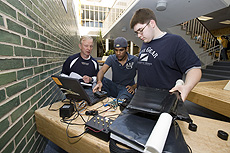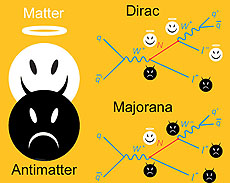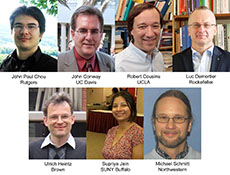|
Have a safe day!
Friday, Sept. 28
3:30 p.m.
DIRECTOR'S COFFEE BREAK - 2nd Flr X-Over
4 p.m.
Joint Experimental-Theoretical Physics Seminar - One West
Speaker: Markus Klute, Massachusetts Institute of Technology
Title: A Future Higgs Factory: CMS at LEP3
Monday, Oct. 1
THERE WILL BE NO PARTICLE ASTROPHYSICS SEMINAR THIS WEEK
3:30 p.m.
DIRECTOR'S COFFEE BREAK - 2nd Flr X-Over
4 p.m.
All Experimenters' Meeting - Curia II
Special Topics: Shutdown Work Status and Plans; DES Operation Status
Click here for NALCAL,
a weekly calendar with links to additional information.
Upcoming conferences |
|
Friday, Sept. 28
- Breakfast: strawberry-stuffed French toast
- Philly steak and cheese
- Chicken fajitas
- King ranch chicken casserole
- Smart cuisine: Tex-Mex turkey pot pie
- Blazin' buffalo wings
- Honey mustard ham and Swiss panini
- Reuben pizza
Wilson Hall Cafe Menu
|
|
Friday, Sept. 28
Dinner
Closed
Wednesday, Oct. 3
Lunch
- Roast pork with apple salsa
- Roasted autumn squashes
- Braised red cabbage
- Plum tart with cream Chantilly
Chez Leon Menu
Call x3524 to make your reservation.
|
|
QuarkNet program receives $6.1 million NSF award to advance science education
 |
Steven Grosland, physics teacher at Glenbrook South High School in Illinois, works with two students on taking cosmic-ray data as part of the QuarkNet program. Fermilab developed the data acquisition system for the cosmic-ray detectors.
|
The University of Notre Dame has received a five-year, $6.1 million award from the National Science Foundation to support the nationwide QuarkNet program, which has inspired teachers and students alike for 15 years.
Fermi National Accelerator Laboratory plays a leading role in managing the QuarkNet program, which receives additional funding from the U.S. Department of Energy. QuarkNet uses particle physics experiments to provide valuable research, training, and mentorship opportunities for high-school teachers. More than 500 teachers across the United States participate in the program.
Through the QuarkNet program, physicists at Fermilab, Notre Dame and 50 other research institutions will continue to mentor teachers in research experiences, enabling them to teach the basic concepts of introductory physics in a context that high-school students find exciting. Faculty, teachers and their students work together as a community of researchers, which not only develops scientific literacy in students, but also attracts young students to careers in science and technology.
Read more
|
October wellness offerings, fitness classes and discounts
Health and Wellness Fair:
Tuesday, Oct. 16, from 11:30 a.m. to 1:30 p.m. on the Wilson Hall 15th-floor crossovers. The fair features vendors, giveaways and drawings for prizes.
Free wellness class:
Weekly Qi Gong, Mindfulness and Tai Chi Easy for Stress Reduction meets Wednesdays, 7 a.m. to 8 a.m. and Fridays, noon to 1 p.m. in Ramsey Auditorium.
Fitness classes:
- Muscle Toning class meets Tuesdays and Thursdays, Oct. 4 to Dec. 18 (no class on Nov. 15 and 22), from 5:30 p.m. to 6:30 p.m. in the Fitness Center. $100/person.
- Butts and Guts, two sessions. Tuesday session meets from Oct. 23 to Dec. 18 (no class Nov. 27). Thursday session meets from Oct. 25 to Dec. 20 (no class Nov. 29). Both sessions meet noon to 12:45 p.m. in the Fitness Center. $58/person/session.
- Zumba meets Fridays, Oct. 26 - Dec. 21 (no class Nov. 23), from noon to 12:45 p.m. in the Fitness Center. $50/person.
- Yoga meets Tuesdays, Oct. 30 - Dec. 18 (no class Nov. 23), from noon to 1 p.m. in Ramsey Auditorium. $90/person.
Employee discounts:
- Fright Fest Tickets at Six Flags Great America
- AMC and Regal movie tickets
- BatteriesPlus
- Journey Cycle and BMX
For more information, contact Jeanne Ecker in the Wellness Office at x2548 or at jecker@fnal.gov.
|
Reminder: 2012 Flexible Spending Accounts
Employees with a 2012 Health Care or Dependent Care Reimbursement Account must spend the remaining balance by the end of the plan year. Health care expenses to be reimbursed with the 2012 health care reimbursement accounts must be incurred by March 15, 2013. Dependent Care expenses for 2012 must be incurred by Dec. 31, 2012. Claims for both types of accounts must be submitted to the plan administrator, Payflex, by April 30, 2013. Any flexible spending contributions remaining after the deadline are forfeited.
Employees submit flexible spending claims to PayFlex online at www.healthhub.com or via fax. Employees can review a list of eligible expenses, view current balances and claims paid online at www.healthhub.com.
The Affordable Care Act, also known as the health care reform act, was passed in 2010 and reduced the maximum that may be contributed to the Health Care Reimbursement Account from $10,000 to $2,500 per household, effective Jan. 1, 2013. As you begin to plan for 2013 flexible spending, visit the online expense calculator at www.healthhub.com to estimate your expenses.
Visit the employee benefits website for more information about your employee benefits.
|
Five ways the brand new Dark Energy Camera will utterly change our understanding of the universe
From Popular Science, Sept. 26, 2012
For something that we know absolutely nothing about, dark energy owns a prominent place in astrophysics. Its discovery won the Nobel Prize even though the very term "dark energy" is a placeholder for a phenomenon we don't really understand, and though its effects are observable dark energy itself—which supposedly makes up three-quarters of the universe—has never been seen and remains unobservable. That's why the Dark Energy Camera—which achieved first light just last week—is such a big deal. With it, we might finally give the term "dark energy" some meaning.
Read more
|
|
Matter = antimatter?
 |
| Ordinary thinking is that matter and antimatter are diametrically different, like good and evil. CMS searched for a Majorana neutrino, a particle that is both a matter particle and an antimatter particle. It is equivalent in this analogy to something being both good and evil. The Dirac neutrino starts out as a matter particle and stays a matter particle throughout. Since for a Majorana neutrino the particle and antiparticle are the same, it is possible for an emitted matter neutrino to subsequently act like an antimatter neutrino. This behavior would result in striking decay patterns that would show up in CMS data. |
Fermilab has an enormous experimental program that studies neutrinos by shooting beams of them at detectors both near and far. It is also possible to study neutrino physics using LHC data. Given that the neutrino sector is still pretty mysterious (for instance, establishing that neutrinos have mass occurred less than a decade and a half ago), there are many questions still to be answered.
The familiar electron, muon and tau neutrinos all have very low mass. This observation underscores the fact that we do not have a coherent picture of how some particles have huge masses while others have very tiny ones. One method to explain neutrinos’ small mass is to postulate that there is another form of neutrino that is extremely massive. According to this idea, the masses of the familiar neutrinos and the new hypothetical heavy neutrino are tied together in such a way that if one gets very small, the other must get very large. For this reason, the idea is called the seesaw mechanism.
The subject of one ongoing debate in the neutrino community is whether neutrinos and antineutrinos are distinctly different particles or the same particle. As explained in an earlier article, if matter and antimatter particles are different, they are called Dirac particles; if they are the same, they are called Majorana particles.
The typical understanding of matter and antimatter is that they retain their “matter” or “antimatter” identity. Once something is “antimatter-like,” it can never again be “matter-like.”
For instance, let’s consider the decay of a W boson into a positively charged lepton and a theoretical heavy Dirac neutrino (ND) – that is, (W+ → l+ + ND(matter)). The W+ boson is neither matter nor antimatter, so the sum of its decay products must similarly be matter-antimatter-neutral. The positively charged lepton is antimatter (all positive leptons are antimatter), so the heavy neutrino would have to be a matter neutrino to cancel out the antimatter property of the charged lepton. Then, if this heavy matter neutrino subsequently decayed into a W boson and charged lepton (ND(matter) → W+ + l- ), the charged lepton would have to be a matter particle, reflecting the matter property of the neutrino.
In contrast, if the heavy neutrino is a Majorana neutrino (NM), it is its own antiparticle. In this case, when the W+ boson decays into a positive lepton and heavy neutrino (W+ → l+ + NM(matter)), this initial decay is the same as that for the Dirac neutrino – the heavy neutrino must be a matter particle to counterbalance the antimatter property of the positively charged lepton. However, in the subsequent process where it’s the heavy neutrino’s turn to decay, since the Majorana neutrino is its own antiparticle, it could then decay as if it were instead an antimatter neutrino (NM(antimatter) → W- + l+), resulting in a positively charged (antimatter) lepton. The net result is that an initial W boson decays into a state where there is extra matter or extra antimatter.
CMS searched for events with two positively or two negatively charged leptons, along with jets that further identified the kinds of collisions that would indicate a Majorana neutrino was formed. No evidence for heavy Majorana neutrinos was observed.
—Don Lincoln
 |
| These physicists contributed to this analysis. |
 |
| Many CMS physics analyses are deeply dependent on a thorough understanding of statistics in order to extract a meaningful result. These U.S. scientists are members of the CMS committee, which works to ensure that all measurements have correctly employed statistical methods. |
|
|